 | ||
Weather 9°C, Wind W at 10 km/h, 88% Humidity | ||
Gibeon ancient city
Gibeon (Hebrew: גבעון, Standard Hebrew Giv'on, Tiberian Hebrew Giḇʻôn) was a Canaanite city north of Jerusalem. The pre-conquest inhabitants of Gibeon, the Gibeonites, were Hivites according to Joshua 10:12 and Joshua 11:19, or Amorites according to 2 Samuel 21:2.
Contents

The remains of Gibeon are located on the south edge of the Palestinian village of Al Jib.
Archaeology

The earliest known mention of Gibeon in an extra-Biblical source is in a list of cities on the wall of the Amum temple at Karnak, celebrating the invasion of Israel by Egyptian Pharaoh Shoshenq I (945-924 BCE).
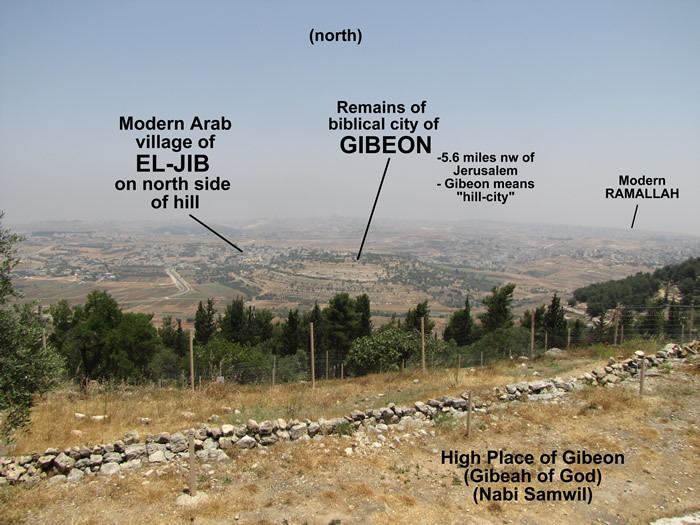
The 10th-century lexicographer, David ben Abraham al-Fasi, identified al-Jib with the ancient city, Gibeon, which view was corroborated also by the Hebrew Lexicon compiled by Wilhelm Gesenius and Frants Buhl ("now al-Ǧīb"). However, the first scientific identification of al-Jib with the ancient Canaanite city of Gibeon was made by Edward Robinson in 1838. The remains of Gibeon were excavated in six expeditions from 1956 to 1962, led by the University of Pennsylvania archaeologist James B. Pritchard.
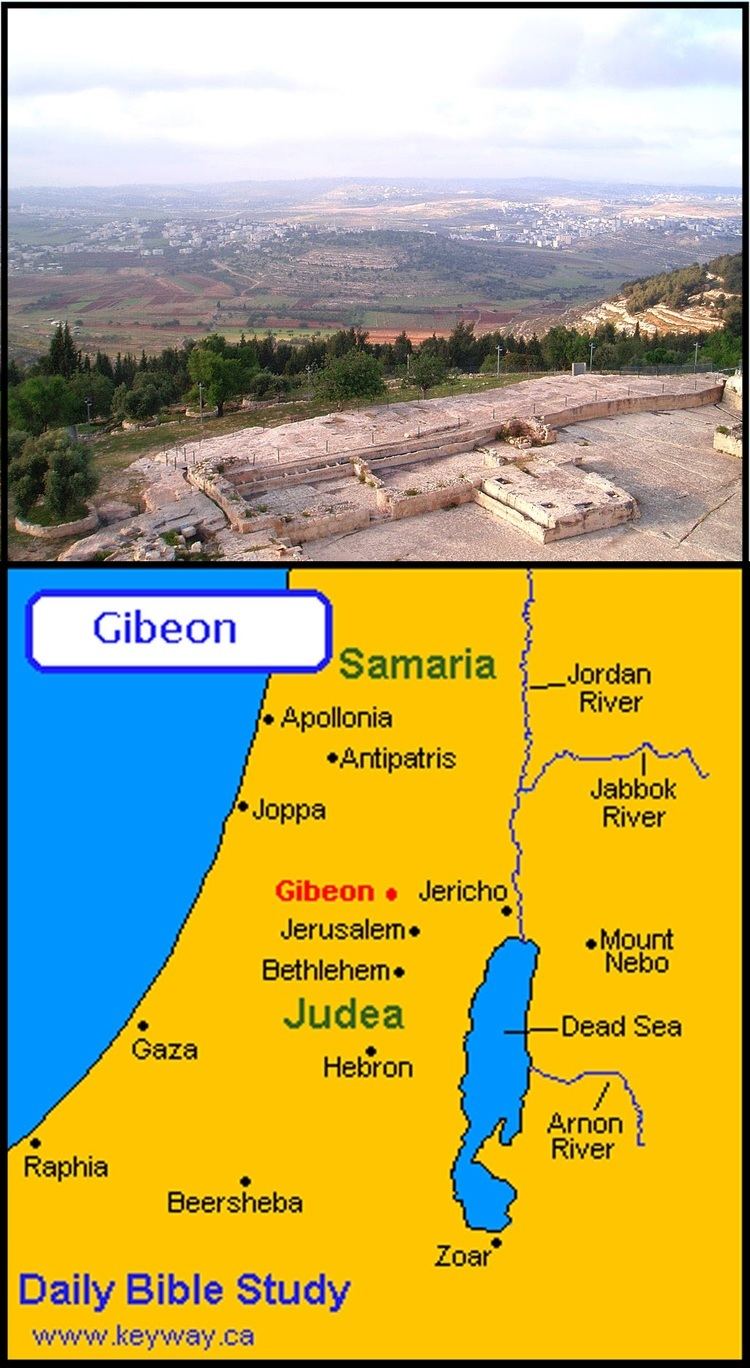
Gibeon was founded in the Early Bronze Age, for the excavators discovered 14 EB storage jars beneath the foundations of the Iron Age wall. Other EB remains were discovered at the top of the tel but the stratigraphy had been destroyed by British gunfire during the First World War. It is probable that there was a defensive wall, but this has not yet been found. Tombs cut into the rock on the east site of the hill contained EB jars and bowls, formed first by hand and then finished on a slow wheel. The Early Bronze city was destroyed by fire, but no date has been determined for this destruction.

The Middle Bronze Age is known from shaft tombs on the west of the city: 26 MBI tombs have been found but the crudeness of the pottery they contain indicate that the people may have been nomads camping on an unfortified site. The remains are similar to those found elsewhere at Jericho, Lachish and Megiddo. In MBII, however, a substantial city with finely made pottery was found. 29 MBII tombs have been found, apparently containing multiple burials (as opposed to the single burials of the MBI tombs).
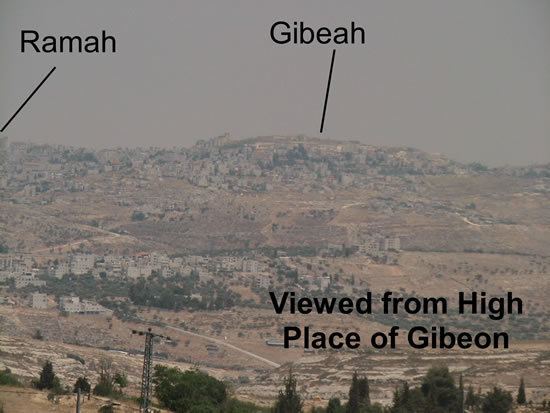
Only seven tombs are known from the Late Bronze period, but they nevertheless point to a degree of sophistication, as they contained imported Cypriote ware and local potters attempted to copy Mycenaean and Cypriote pottery. It would appear that some, at least, of these tombs had been cut during earlier periods and were being reused.

During the early Iron Age, a massive wall was constructed around the crown of the hill and a huge pool was cut in the living rock just inside the wall. It is 11.8m in diameter and 10.8m deep, with a spiral staircase of 79 steps cut into the walls of the pool, continuing downwards into a tunnel that provides access to a water chamber 24m below the level of the city. It is possible, but cannot be proven, that this structure is the "Pool of Gibeon" of 2 Samuel 2:13. Later in the Iron Age, another tunnel of 93 steps was constructed to a better water source below the city starting from a point near the pool. A second access point to this source from the base of the hill is still in use today. This was apparently the city's period of greatest prosperity.
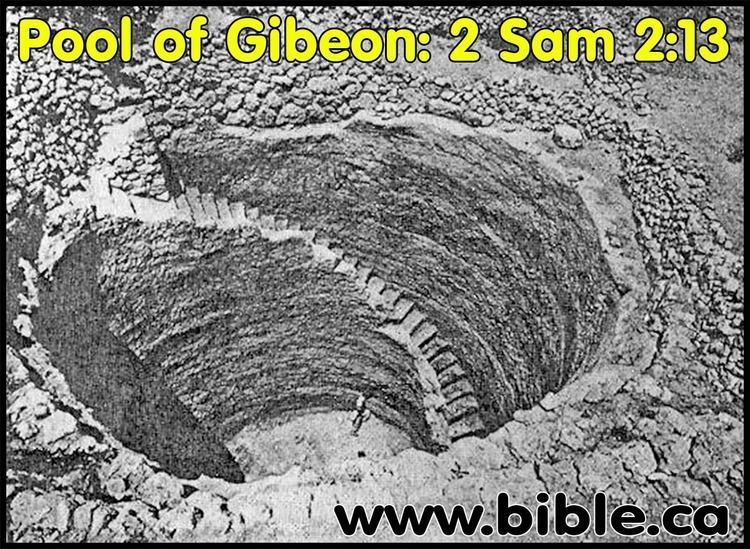
In the 8th and 7th century BCE there was a considerable wine industry there; cellars with room for 95,000 liters of wine have been found. Impressive among these finds are sixty-three wine cellars from the 8th to 7th century BC. Hebrew inscriptions of גבען (GBʻN) on the handles of wine storage jars, most of which were excavated from a large pool matching the biblical description, made the identification of Gibeon secure and a landmark product of biblical archaeology. Pritchard published articles on their production of wine, the Hebrew inscriptions, the rock-cut wine cellars, and the well engineered water conduits that supplied the city water.
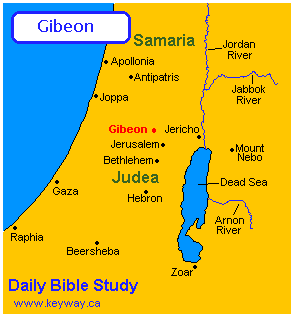
From the 6th to the beginning of the 1st century BCE, there is scant evidence of occupation. During the Roman period there was considerable building, including stepped baths and water conduits.
Gibeon was possibly a dependency of Jerusalem, and was probably not fortified at the time.

The identification of the ancient Canaanite city of Gibeon with modern al-Jib, conjectured since the 17th century, was proved by Hebrew inscriptions unearthed in 1956.
Canaanite Gibeon
After the destruction of Jericho and Ai, the people of Gibeon (Hivites) sent ambassadors to trick Joshua and the Israelites into making a treaty with them. According to the Bible, the Israelites were commanded to destroy all inhabitants of Canaan. The Gibeonites presented themselves as ambassadors from a distant, powerful land. Without consulting God (Joshua 9:14), Israel entered into a mutual pact with the Gibeonites. Joshua realized he had been deceived, but he kept the letter of his covenant with the Gibeonites to let them live; however, he cursed and enslaved them as woodcutters and water-carriers (Joshua 9:3-27).
In retaliation for allying with the Israelites, the city was later besieged by a coalition of five other Amorite kings led by Adonizedek, king of Jerusalem, along with Hoham of Hebron, Piram of Jarmuth, Japhia of Lachish, and Debir of Eglon. The Gibeonites appealed to Joshua, who led the subsequent victory over the Amorites amid miraculous circumstances, including deadly hailstones and the suspension of the movement of the sun and moon until the Amorites were completely defeated. (Joshua 10:1-15)
2 Samuel 21:2 indicates that Saul pursued the Gibeonites and sought to kill them off "in his zeal for the children of Israel and Judah". (2 Samuel 21:5)
Much later, after the death of Absalom and king David's restoration to his throne, Israel was visited by a grievous famine, which was believed to be as a result of King Saul's treatment of the Gibeonites. (2 Samuel 21:1)
As an Israelite city
Gibeon was located in the tribal territory of Benjamin (Joshua 18:25), and it was given as a Levitical city (Joshua 21:17). The city is also the place where God made the sun stand still during the Israelites' war with the Amorites (Joshua 10:12). In the first Book of Chronicles, Jeiel is mentioned as the "father of Gibeon" and is an ancestor of King Saul.
The fight between the soldiers of Joab and those of Abner took place beside the pool of Gibeon (2 Samuel 2:12). It was in this area that David conquered the Philistines (2 Samuel 5:25 and 1 Chronicles 14:16).
After David became king of the United Monarchy, a three-year drought made him ask God what was wrong. God indicated his anger at Saul massacring the Gibeonites with whom Israel had made a covenant in the Lord's name. In retribution, the decimated Gibeonites asked for seven of Saul's male descendants to be given to them to kill, seven signalling the sign of completion. David handed over Armoni and Mephibosheth, two of the sons of Saul and the five sons of Merab (Saul's daughter) to the Gibeonites, who hanged them. He saved Jonathan's son, also Mephibosheth from this peril because of his covenant with Jonathan (2 Samuel 21:1-9).
Amasa was also killed here (2 Samuel 20:8). There was a "great high place" in Gibeon where Solomon offered one thousand burnt offerings (1 Kings 3:4). On this occasion God appeared to him in a dream (1 Kings 3:5) and granted him wisdom (1 Kings 3: 12). Hananiah came from this city (Jeremiah 28:1 ). After the exile of the Israelites to Babylon, Gibeon belonged to Judea (Nehemiah 3:7). For some period of time, the Tabernacle of the LORD was set up here at the high place. (1 Chronicles 21:29)
In the Book of Joshua, ancient Jib or Gibeon is described as "a large city, like one of the royal cities", and as being the place where Joshua made the sun stand still (Joshua 10:12). The flat and fertile land with many springs which surrounds it gave rise to a flourishing economy, attested to in the large number of ancient jars and wine cellars discovered there. The jars could hold 45 liters of wine each and 66 wine cellars two meters deep and dug out of rock have been unearthed in Jib.
In Jewish law
In Rabbinic Judaism, the alleged descendants of the Gibeonites, known as Natinim, are treated differently from ordinary Jews. They may not, for example, marry a Jew by birth. However, a Natin may marry Mamzerim and Gerim.
